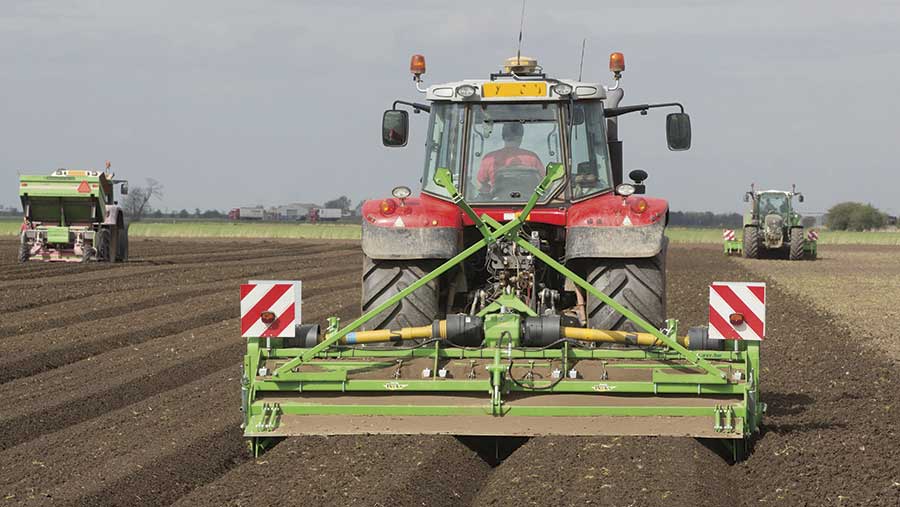3 pesticide approvals to look out for in 2017
 © Tim Scrivener
© Tim Scrivener Two herbicides and a potato blight fungicide are some of the key pesticides set to gain approval for the coming spring.
It may often seem that all it’s all about products being lost, but there are some approvals in the coming months that will benefit cereal and spud growers, including a key grassweed product gaining full approval for spring wheat and a new in-furrow potato fungicide.
See also: Rule reminder: Key pesticide stewardship guidelines
Here Crops takes a closer look at the three key changes for arable farmers to look out for in 2017.
Herbicide Liberator gets full spring wheat approval
Bayer’s mainstay of grassweed control in winter wheat and winter barley, Liberator (flufenacet + diflufenican), now has full label approval for application in spring wheat crops.
Grassweed challenges, particularly blackgrass, have increased interest in spring crops over recent years as growers look to get on top of high populations with a larger window for pre-crop control.
With few fully approved herbicide options available in spring cereals, Bayer responded to increased demand by having spring wheat added to Liberator label.
Growers were previously able to use the product in spring wheat, but required an Extension of Authorisation for Minor Use (Eamu).
The new label permits one application of 0.3 litres/ha, before the crop reaches growth stage 14.
Farms with old-label Liberator left in the shed will still be able to use it on spring wheat next year, provided they print a copy of the new label, which will be available on the Bayer website soon.
This registration does not apply to Liberator use in spring barley – it can still be used, but growers must have a copy of the Eamu.
BASF gains approval for in-furrow potato fungicide
BASF has got an earlier-than-expected approval for its new potato fungicide Sercadis, although it will only be launched in small quantities on a test market during 2017.
Containing the company’s Xemium-branded active fluxapyroxad – contained in cereal fungicides Adexar and Librax – it is a liquid formulation applied in-furrow at planting and looks set to rival market leader Amistar (azoxystrobin).
BASF state 2017 will be a year for itself and the UK potato industry to gain in-field experience with Sercadis and is anticipated to go fully commercial for 2018.
It is already widely used in other parts of the world and the product’s disease control spectrum will be similar to Amistar, with a main target of soil-borne rhizoctonia. Trials have shown the product to have good crop safety.
Avadex liquid set for autumn 2017 launch
US-based company Gowan has had the regulatory thumbs-up for a new liquid formation of herbicide tri-allate and is set to be available for autumn 2017 plantings.
Granular tri-allate product Avadex Excel 15G has gained in popularity over recent seasons, proving a consistently useful addition to pre-emergence herbicide stacks to control a range of grassweeds.
New product AvadeX Factor is a capsule suspension containing 450g/litre of tri-allate and allows delivery through a conventional boom sprayer to winter wheat, winter barley and spring barley crops.
It can be applied once at pre-emergence and has a maximum total dose of 3.6 litres/ha. It also has a non-reducable 15m aquatic buffer zone around watercourses.
Gowan told Crops that the product delivers 1,620g/ha of tri-allate, while Avadex Excel 15G granules deliver 2,250 g/ha of tri-allate, so there will be a dose response for granules over liquid.
The company plan to have the product available for autumn 2017 through normal distribution channels and said that pricing has not yet been confirmed.
Potato fungicide Curzate gets restrictions tightened
Popular potato blight fungicide product Curzate has seen some significant changes made to its conditions of use.
The product previously had no restriction on maximum number of doses, no aquatic buffer zone and no latest growth stage for application.
Its new label now stipulates a maximum of six applications and it can’t be applied after beginning of leaf yellowing (BBCH 90).
A Local Environmental Risk Assessment for Pesticides B 5m aquatic buffer zone has also been added, which can be reduced to 1m if justified under the circumstances of application.
It should be noted the product will maintain the same Ministerially Approved Pesticide Product number (11901), despite the changes.
Manufacturer DuPont has indicated that stock for use during the 2017 season will carry the old label without any added restrictions, so will only begin to impact on blight programmes from spring 2018.
Pesticide watch
Crops is working with Gatekeeper agronomists to highlight key pesticide rule changes and the potential implications, keeping you on the right side of the law and aiding on-farm record keeping.
Sentinel is a decision-support tool linked to Gatekeeper crop-management software, a programme that helps arable farmers with record-keeping and legislation issues.

